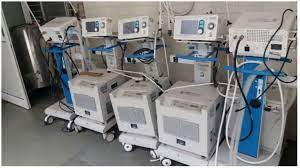In the fast-paced world of industries and businesses, equipment and machinery are the backbone of operations. From manufacturing plants to healthcare facilities, having reliable equipment is crucial. But like any well-oiled machine, these pieces of equipment also require regular check-ups to ensure they perform optimally. In this blog post, we’ll explore the significance of regular equipment check-ups and maintenance strategies and how they contribute to seamless operations.
1. Preventing Costly Breakdowns:
One of the most compelling reasons for regular equipment check-ups is the prevention of costly breakdowns. When equipment suddenly fails, it not only disrupts operations but the failure can also lead to expensive emergency repairs or replacements. Routine check-ups can identify issues early, allowing for timely maintenance to prevent breakdowns.
2. Extending Equipment Lifespan:
Properly maintained equipment tends to have a longer lifespan. Regular check-ups can address wear and tear, replace worn-out parts, and move equipment regularly keep the machinery in good working condition. This extends the life of your equipment, reducing the need for frequent replacements and saving on long-term costs.
3. Maintaining Safety Standards:
Safety is a paramount concern in many industries. Regular equipment inspections help ensure that machinery is in compliance with safety standards. This not only protects the well-being of employees but also prevents potential legal issues and fines resulting from non-compliance with safety devices.
4. Enhancing Efficiency:
Well-maintained equipment operates at peak efficiency. This means better productivity, reduced energy consumption, and cost savings. Regular check-ups can fine-tune equipment to perform optimally, contributing to make maintenance work a more efficient workflow.
5. Minimizing Downtime:
Downtime can be a significant disruptor in any industry. Regular equipment maintenance reduces the risk of unexpected breakdowns and the subsequent downtime they cause. Scheduled check-ups allow for planned maintenance, minimizing the potential issues and disruptions to your operations.
6. Cost Savings:
While it might seem counterintuitive, investing in regular equipment check-ups can save you money in the long run. Preventative maintenance is often more cost-effective than emergency repairs or replacements of faulty equipment. It’s an investment in the longevity and reliability of your equipment.
7. Compliance and Regulations:
Many industries are subject to regulations, legislation and compliance standards that require regular equipment inspections. Failing to meet these requirements can lead to fines and legal consequences. Regular check-ups ensure that your equipment complies with these standards.
8. Environmental Impact:
For businesses focused on sustainability, well-maintained equipment can contribute to a reduced environmental footprint. Efficient equipment consumes less energy, emits fewer pollutants, and minimizes waste.
9. Employee Morale:
A well-maintained working environment, including reliable equipment, can boost employee morale. When employees feel that their workplace is safe, efficient, and well-cared for, it can lead to increased job satisfaction and productivity.
Health and Safety Executive
The Health and Safety Executive (HSE) is a vital regulatory body in the United Kingdom responsible for ensuring the health, safety, and well-being of workers and the public in the workplace. Established under the Health and Safety at Work etc. Act 1974, the HSE plays a pivotal role in setting and enforcing safety standards across various industries and sectors.
Key Responsibilities of the Health and Safety Executive (HSE):
- Regulation and Enforcement: The HSE develops and enforces regulations and guidelines to safeguard the health and safety of workers in the workplace. It conducts inspections and investigations to ensure compliance.
- Risk Assessment: HSE encourages employers to assess and manage risks in the workplace, promoting a culture of safety and prevention.
- Research and Guidance: The HSE conducts research and provides valuable guidance and resources to businesses, helping them understand and implement safety measures effectively.
- Accident and Incident Reporting: The HSE oversees the reporting of workplace accidents, injuries, and incidents. This data helps in identifying trends and areas that need improvement.
- Education and Training: The HSE offers training and educational materials to raise awareness of health and safety issues and promote best practices.
- Licensing and Certification: In some industries, the HSE issues licenses and certifications to ensure that individuals and businesses meet specific safety standards.
- Promotion of Safety Culture: The HSE promotes a safety culture within organisations, encouraging proactive safety measures and the well-being of workers.
- Emergencies and Hazardous Substances: It provides guidelines for dealing with emergencies, including hazardous substances and materials that may pose risks to health and safety.
Working with the Health and Safety Executive:
Businesses and organizations in the UK must collaborate with the HSE to ensure compliance with health and safety regulations. This typically involves:
- Risk Assessment: Identifying and addressing workplace hazards and risks, and implementing necessary safety measures.
- Record-Keeping: Maintaining detailed records of safety-related activities, including accidents and near misses.
- Training and Education: Providing appropriate training and information to employees to ensure they understand and follow safety procedures.
- Cooperation: Collaborating with the HSE during inspections, investigations, and audits, and addressing any concerns promptly.
- Continuous Improvement: Regularly reviewing and enhancing health and safety policies and practices to ensure the well-being of employees and the public.
The Importance of Equipment Maintenance:
- Prevent Costly Breakdowns: Regular equipment maintenance helps identify and address issues before they lead to expensive breakdowns, saving you from costly emergency repairs or replacements.
- Extend Equipment Lifespan: Properly maintained equipment lasts longer. Routine checks and maintenance help to prevent wear and tear, increasing the lifespan of your machinery.
- Ensure Safety: Maintenance plays a crucial role in ensuring the safety of employees and the public. Well-maintained equipment is less likely to malfunction or pose safety risks.
- Optimize Efficiency: Regular maintenance fine-tunes equipment to perform optimally. This results in improved efficiency, reduced energy consumption, and cost savings.
- Minimize Downtime: Unplanned downtime can disrupt operations and cost your business time and money. Scheduled maintenance minimizes downtime by addressing issues proactively.
Best Practices for Equipment Maintenance:
- Scheduled Inspections: Establish a regular maintenance schedule based on manufacturer recommendations and usage. This includes daily, weekly, monthly, and annual checks.
- Lubrication: Proper lubrication of moving parts is essential. Regularly inspect and top up oil and grease levels to reduce friction and wear.
- Replace Worn Parts: Identify and replace worn or damaged components. Keeping spare parts on hand can reduce downtime.
- Cleaning and Calibration: Regularly clean equipment and calibrate it to maintain accuracy. Cleanliness and precision are key to machinery performance.
- Safety Checks: Include safety checks in your maintenance routine to ensure that safety features are functioning correctly.
- Record Keeping: Maintain detailed records of all maintenance activities, including inspection dates, repairs, and parts replacement.
- Training: Ensure that your maintenance team is well-trained and knowledgeable in equipment-specific maintenance procedures.
- Emergency Response Plan: Develop a clear plan for addressing equipment failures and breakdowns. This should include procedures for obtaining emergency repairs or replacements.
- Regular Staff Training: Educate your staff on the importance of equipment maintenance and how to recognize and report issues.
- Proactive Approach: Encourage a proactive attitude towards maintenance. Employees should be encouraged to report any anomalies they observe in equipment performance.
Work Equipment Regulations
The Work Equipment Regulations, specifically known as the “Provision and Use of Work Equipment Regulations 1998” (PUWER), are a set of essential health and safety regulations in the United Kingdom. These regulations are designed to ensure that work equipment used in various industries and workplaces is safe, suitable, and well-maintained. Compliance with PUWER is crucial to protect the health and safety of employees and the public.
Key Aspects of the Provision and Use of Work Equipment Regulations 1998 (PUWER):
- Scope: PUWER applies to all work equipment used by employees in their work. This includes machinery, tools, appliances, and equipment of any kind.
- Duty Holder Responsibilities: The regulations place responsibilities on employers, the self-employed, and anyone who controls the use of work equipment. They are collectively referred to as “duty holders.”
- Equipment Safety: Employers must ensure that all work equipment is suitable for its intended use, safe to operate, and properly maintained. This includes regular inspections and necessary repairs or replacements.
- Training and Information: Employers must provide adequate training and information to employees who use work equipment. This training should cover safe operation, maintenance, and risk assessments.
- Safe Use and Operation: Employees are required to use work equipment in accordance with the training and instructions provided. They should report any defects or safety concerns promptly.
- Risk Assessment: Employers must conduct risk assessments to identify and mitigate potential risks associated with the use of work equipment. This includes addressing any specific risks and ensuring safety measures are in place.
- Maintenance and Inspection: Work equipment must be maintained in good working order. Regular inspections, servicing, and repairs should be carried out to address defects and maintain safety.
- Protection Measures: The regulations mandate the use of safety measures, including guards, protective devices, and safety interlocks, to prevent accidents and injuries when using work equipment.
- Safe Access and Egress: Employers are required to provide safe access and egress to and from work equipment, ensuring that employees can operate it safely.
- Marking and Identification: Work equipment should be marked with essential safety information and warnings, making users aware of potential hazards.
- Imported Equipment: Imported work equipment must meet UK safety standards and be CE marked, indicating compliance with European Union regulations.
- Lifting Equipment: Specific regulations under PUWER pertain to lifting equipment, including cranes, hoists, and forklifts, ensuring their safe use and maintenance.
Maintenance Costs:
Maintenance costs encompass the expenses associated with the regular upkeep, repair, and servicing of equipment, machinery power supplies, and infrastructure. These costs are crucial for preserving the operational efficiency and safety of a business or facility.
In conclusion, regular equipment check-ups are not just a maintenance task; they are an investment in the reliability, safety, and efficiency of your operations. Preventative maintenance not only prevents costly breakdowns but also extends the lifespan of your equipment, saving you money in the long run. It’s a proactive approach that ensures your business’ system runs smoothly and efficiently, contributing to its success and growth.

